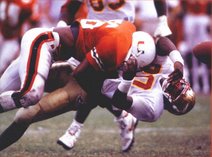Paul Johnson had remarkable success at Navy turning the Midshipmen into a perennial bowl team. But because Johnson ran the Flexbone option it seemed like he was passed over for every major Head Coaching opening in the nation. Navy's record under Johnson was its best since the 1950s yet because he advocated the option in the day and age of spread passing offenses he was ridiculed as someone who could not coach at a big time program.
Finally, Johnson got a BCS league gig at Georgia Tech and is now trying to build the program around his triple option flexbone offense. The Jackets are likely to go through growing pains the next year or two as the offense makes due with players recruited by Chan Gailey to run a pro style attack. Georgia Tech is now the first school to run this offense in a major conference since the late 1980s.
The Triple Option requires an intelligent and fast QB. Josh Nesbitt fits this system well but his backups on Georgia Tech do not. That is why Nesbitt's injury is a huge boon to the Canes chances on Thursday night. If Nesbitt is not a 100%, he will not be able to make the plays with his feet in the way he did earlier in the season, and the entire triple option attack will be slowed. Nesbitt's reads at the line of scrimmage won't change, but the quickness of execution will regress if he is not fully healthy.
In the offense the slotbacks often times come in motion or trail the QB so they can recieve a pitch. The fullback, which for Georgia Tech is Jonathan Dwyer typically is the first option in the flexbone: he either takes the handoff right behind the line of scrimmage or dives into the line simulating a hand off while the play develops behind the line. Florida State's D-line was suckered into biting on a number of these fakes early in this month's matchup with the Jackets. Following this, FSU began to over compensate by assigning multiple defenders to the slotbacks which then gave Tech the ability actually run Dwyer right up the middle several times with great success.
Another difference between the flexbone and the traditional wishbone option is the ability of the QB using one our two WR's who run lateral blocking routes downfield to actually release on long passing route. Again, Florida State bit on this which gave Nesbitt the ability to throw downfield a few times to the Jacket receivers who appeared to be simply blocking on a play.
This offense can be very difficult to stop. I've seen many commentators this week discuss Miami's role in the death of the wishbone offense. This is very true as Nebraska and Oklahoma not only could not move the ball with much success against Miami during the big games of the 1980s but they did not have the speed to slow down Miami's passing attack. Nebraska had similar problems the many times they faced Florida State in the 1980s as well. However, the only team to run a similar offense to what Georgia Tech runs currently that Miami faced in the 1980s was Arkansas. While the Canes smashed the Hogs on the road in 1987, the 1988 rematch in Miami showed the Hurricanes inability to play assignment football. Quinn Groovy the Arkansas QB had a great game with his feet and the Canes needed a last minute Greg Cox FG to come from behind for the win. The offense had also served its purpose of controlling the clock and keeping Steve Walsh off the field. While Miami won the game it wasn't with the ease that the games at the same point in time versus traditional wishbone schools like Oklahoma were being won with.
Tuesday, November 18, 2008
Explaining the Flexbone Triple Option
Labels:
Flexbone Offense,
Miami Football
blog comments powered by Disqus





